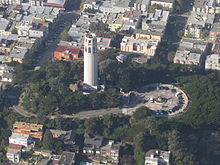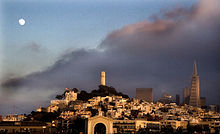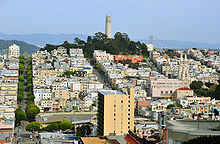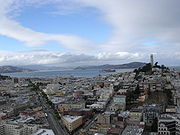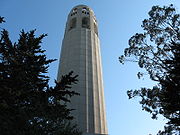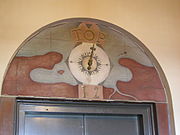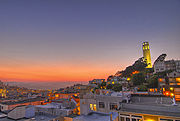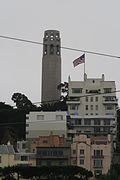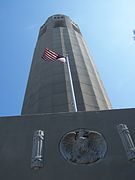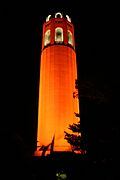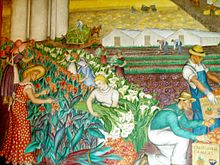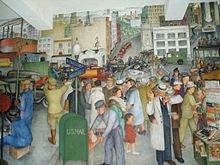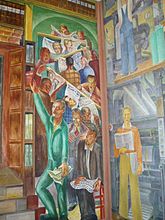- Coit Tower
-
Coit Memorial Tower
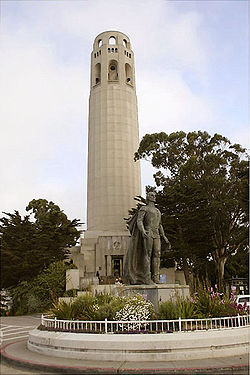
Location: 1 Telegraph Hill Blvd
San Francisco, CaliforniaNRHP Reference#: 07001468 Added to NRHP: January 29, 2008 Coit Tower is a 210-foot (64 m) tower in the Telegraph Hill neighborhood of San Francisco, California. The tower, in the city's Pioneer Park, was built in 1933 at the request of Lillie Hitchcock Coit to beautify the city of San Francisco; Coit bequeathed one-third of her estate to the city "to be expended in an appropriate manner for the purpose of adding to the beauty of the city which I have always loved".[1]
The art deco tower, made of unpainted reinforced concrete, was designed by architects Arthur Brown, Jr. and Henry Howard, with fresco murals by 27 different on-site artists and their numerous assistants, plus two additional paintings installed after creation off-site.[citation needed]
The tower was not designed to resemble a fire hose nozzle,[2] despite Coit's affinity with the San Francisco firefighters of the day, in particular with Knickerbocker Engine Company Number 5.
Contents
History
Coit Tower was paid for with money bequested by Lillie Hitchcock Coit, a wealthy socialite who loved to chase fires in the early days of the city's history. The tower took five years to construct. Before December 1866, there was no real fire department, and fires in the city, which broke out regularly in the wooden buildings, were extinguished by several volunteer fire companies.
Lillie Coit was one of the more eccentric characters in the history of North Beach and Telegraph Hill, smoking cigars and wearing trousers long before it was socially acceptable for women to do so. She was an avid gambler and often dressed like a man in order to gamble in the males-only establishments that dotted North Beach. Coit was reputed to have shaved her head so her wigs would fit better.
Lillie's fortunes funded the monument four years following her death in 1929, as she had requested. She had a special relationship with the city's firefighters. At the age of fifteen she witnessed the Knickerbocker Engine Co. No. 5 in response to a fire call up on Telegraph Hill when they were shorthanded, and threw her school books to the ground and pitched in to help, calling out to other bystanders to help get the engine up the hill to the fire, to get the first water onto the blaze. After that Lillie became the Engine Co. mascot and could barely be constrained by her parents from jumping into action at the sound of every fire bell. After this she was frequently riding with the Knickerbocker Engine Co. 5, especially so in street parades and celebrations in which the Engine Co. participated. Through her youth and adulthood Lillie was recognized as an honorary firefighter.
Her will read that she wished for one third of her fortune "to be expended in an appropriate manner for the purpose of adding to the beauty of the city which I have always loved." Two memorials were built in her name. One was Coit Tower, and the other was a sculpture depicting three firemen, one of them carrying a woman in his arms. Lillie is today the matron saint of San Francisco firefighters.[3]
Murals
The Coit Tower murals were done under the auspices of the Public Works of Art Project, the first of the New Deal federal employment programs for artists. Ralph Stackpole and Bernard Zakheim successfully sought the commission in 1933, and supervised the muralists, who were mainly faculty and students of the California School of Fine Arts (CSFA), including Maxine Albro, Victor Arnautoff, Ray Bertrand, Rinaldo Cuneo, Mallette Harold Dean, Clifford Wight, Edith Hamlin, George Harris, Robert B. Howard, Otis Oldfield, Suzanne Scheuer, Hebe Daum and Frede Vidar.[4]
After Diego Rivera's Man at the Crossroads mural was destroyed by its Rockefeller Center patrons for the inclusion of an image of Lenin, the Coit Tower muralists protested, picketing the tower. Sympathy for Rivera led some artists to incorporate leftist ideas and composition elements in their works. Bernard Zakheim's "Library" depicts fellow artist John Langley Howard crumpling a newspaper in his left hand as he reaches for a shelved copy of Karl Marx's Das Kapital with his right, and Stackpole is painted reading a newspaper headline announcing the destruction of Rivera's mural; Victor Arnautoff's "City Life" includes The New Masses and The Daily Worker periodicals in the scene's news stand rack; John Langley Howard's mural depicts an ethnically diverse Labor March as well as showing a destitute family panning for gold while a rich family observes; and Stackpole's Industries of California was composed along the same lines as an early study of the destroyed Man at the Crossroads.[5]
Two of the murals are of San Francisco Bay scenes. Most murals are done in fresco; the exceptions are one mural done in egg tempera (upstairs, in the last decorated room) and the works done in the elevator foyer, which are oil on canvas. While most of the murals have been restored, a small segment (the spiral stairway exit to the observation platform) was not restored but durably painted over with epoxy surfacing.
Most of the murals are open for public viewing without charge during open hours, although there are ongoing negotiations by the Recreation and Parks Department of San Francisco to begin charging visitors a fee to enter the mural rotunda. The murals in the spiral stairway, normally closed to the public, are open for viewing on Saturday mornings at 11:00 am with a free San Francisco City Guides tour.
Since 2004 artist Ben Wood has collaborated with other artists on large scale video projections onto the exterior of Coit Tower, in 2004, 2006, 2008 & 2009.[6]
The view
The tower, which stands atop Telegraph Hill in San Francisco's Pioneer Park, offers fantastic views of San Francisco including the Golden Gate Bridge, the San Francisco Maritime National Historical Park ("Aquatic Park"), Alcatraz, Pier 39, Angel Island, Treasure Island, the Bay Bridge, Russian Hill, the Financial District, Lombard Street, and Nob Hill.
Getting to Coit Tower
Due to the extreme topography, the parking lot at the top of the hill is only accessible by one road, Telegraph Hill Boulevard via Lombard Street. Because Coit Tower is such a popular tourist attraction, at peak times, the street can be backed up and the wait for parking to open up can be long. The alternatives to driving and parking are to come by bus or to walk. It is a short bus ride to Coit Tower from the Fisherman's Wharf area or from Washington Square in North Beach on the #39 bus which leaves every 20 minutes. A system of wooden and concrete stairs and footpaths, called the Filbert Steps, lead to the top of the hill from various directions, making a steep but direct climb possible.
Telegraph Hill Boulevard connects with Lombard Street, another popular tourist attraction.
Media
- In the book trilogy Nine Lives Of Chloe King by Celia Thomson, the protagonist Chloe King loses one of her nine lives by falling from Coit Tower.
- In the books Signal to Noise and A Signal Shattered by Eric Nylund, the tower is saved from numerous disasters and becomes a metaphor for the protagonist's determination to survive.
- In the book On The Road by beat writer Jack Kerouac, the Coit Tower is one of the symbols of San Francisco : "That was Frisco; and beautiful women standing in white doorways, waiting for their men; Coit Tower and the Embarcadero, and Market Street, and the eleven teeming hills."
- Another beat writer, the poet Lawrence Ferlinghetti, makes reference to the "Coit's Tower" in his poem "Dog".
- In the 1998 movie Dr. Dolittle, Eddie Murphy tries to coax a sick, suicidal tiger from jumping off the tower.
- In the Dirty Harry movie The Enforcer, Kate Moore calls the tower "coitus interruptus", claiming it looked "vaguely phallic".
- In A Dirty Job by Christopher Moore, the phallic appearance of the tower as well as its origins are mentioned.
- In the film Vertigo Coit Tower appears in many background shots; the film's director, Alfred Hitchcock said he used it as a phallic symbol.[7] The tower is also explicitly mentioned in the dialogue as a recognizable landmark: "That's the first time I've been grateful for Coit Tower."[8]
- Bill O'Reilly, on The O'Reilly Factor, caused controversy when he made the following comments to the people of San Francisco: "Listen, citizens of San Francisco, if you vote against military recruiting, you're not going to get another nickel in federal funds. Fine. You want to be your own country? Go right ahead. And if Al Qaeda comes in here and blows you up, we're not going to do anything about it. We're going to say, look, every other place in America is off limits to you, except San Francisco. You want to blow up the Coit Tower? Go ahead."[9]
- On the season finale of the CBS reality television program The Amazing Race 16, airing on May 9, 2010, Coit Tower was the site of the first task of that episode of the program, whereby one member of each of the three final teams had to climb up and back down Coit tower, with the clue obtained from the top of the tower in hand, in order to proceed to the next task or clue.
Photo gallery
The murals
See also
- List of towers
- History of San Francisco
- 49-Mile Scenic Drive
References
- ^ Pryor, Alton (2003). Fascinating Women in California History. Stagecoach Pub.. pp. 86. ISBN 0966005392.
- ^ Crowe, Michael F. and Robert W. Bowen (2007). Images of America: San Francisco Art Deco. Arcadia Publishing. pp. 72. ISBN 978-0-7385-4734-3.
- ^ http://www.bbc.co.uk/dna/h2g2/alabaster/A5849058
- ^ San Francisco Art Institute. The Commission. SFAI Offers Diego Rivera His Second Commission in the US
- ^ Lee, Anthony W. (1999). Painting on the Left: Diego Rivera, Radical Politics, and San Francisco's Public Murals. University of California Press. ISBN 0520219775. http://books.google.com/books?id=sEvM9s8NekkC.
- ^ Berton, Justin (November 23, 2009). "Tower of films to recall Alcatraz takeover". The San Francisco Chronicle. http://articles.sfgate.com/2009-11-23/bay-area/17182135_1_coit-tower-projectors-film.
- ^ Chandler, Charlotte (2005). It's Only A Movie. Simon & Schuster. pp. 246. ISBN 0743245083. http://books.google.com/books?id=aUzfAcXfUNgC&pg=PA246&lpg=PA246&dq=%22alfred+hitchcock%22+%22phallic+symbol%22.
- ^ Vertigo review at filmsite.org
- ^ http://mediamatters.org/mmtv/200511100008
External links
- video of tower history and mural tour
- Coit Tower at Structurae
- Coit Tower page in New Deal Art Registry
- Photography of Telegraph Hill by Bennett Hall
Coordinates: 37°48′09″N 122°24′21″W / 37.8024°N 122.4058°W
U.S. National Register of Historic Places Topics Lists by states Alabama • Alaska • Arizona • Arkansas • California • Colorado • Connecticut • Delaware • Florida • Georgia • Hawaii • Idaho • Illinois • Indiana • Iowa • Kansas • Kentucky • Louisiana • Maine • Maryland • Massachusetts • Michigan • Minnesota • Mississippi • Missouri • Montana • Nebraska • Nevada • New Hampshire • New Jersey • New Mexico • New York • North Carolina • North Dakota • Ohio • Oklahoma • Oregon • Pennsylvania • Rhode Island • South Carolina • South Dakota • Tennessee • Texas • Utah • Vermont • Virginia • Washington • West Virginia • Wisconsin • WyomingLists by territories Lists by associated states Other Categories:- Art Deco buildings in California
- Landmarks in San Francisco, California
- Buildings and structures in San Francisco, California
- Towers in California
- 1933 architecture
- National Register of Historic Places in San Francisco, California
- Federal Art Project
- Public Works of Art Project
- Art Deco sculptures and memorials
- Visitor attractions in San Francisco, California
- Buildings and structures on the National Register of Historic Places in California
Wikimedia Foundation. 2010.

